
looks over the project maps with PBOT
Traffic Engineer Rob Burchfield and
City Bike Coordinator Roger Geller.
(Photos © J. Maus/BikePortland)
Last night the City of Portland and representatives from the Lloyd Transportation Management Association hosted an open house for their NE Multnomah Street Transportation Pilot Project. It was the first time the public was shown the proposals for this project.
If you recall, back in October a citizen committee ended a 10 month public process with a 12-1 vote in favor of moving forward in making NE Holladay the main east-west spine for safe and convenient bicycling through the Lloyd District. That lone dissenting vote was held by the most powerful man in the room (or perhaps just the most feared) — Wade Lange of commercial real estate firm Ashforth Pacific. Lange — who was also representing a San Diego real estate firm that had just purchased $92 million worth of Ashforth property (the majority of which is on Multnomah Street) — never made it clear exactly why he opposed the project on Holladay; but despite being outvoted 12-1, he convinced the City of Portland to turn their attention away from Holladay and toward Multnomah instead.
By March, Lange found himself on a 25 person task force charged with putting Multnomah on a road diet. The task force was made up of PBOT staff, TriMet, the Portland Development Commission, property owners, and other stakeholders. Since then, they’ve met three times to come up with a plan to make significant changes to the street.
At the open house last night, the poster boards explaining the genesis of this project made no mention of Holladay. Instead, this is how the project was introduced:
“NE Multnomah Street was suggested as the prime east-west retail corridor as part of the N/NE Quadrant project. In its existing form NE Multnomah leaves little space for on-street parking, and active transportation that would invite shoppers, visitors, pedestrians, cyclists and transit riders to one of Portland’s premier districts.”
In order to turn the “outdated” street into one that will “energize the Lloyd District and create a vibrant east-west retail spine” on NE Multnomah, the first phase of the project will:
- add around 70 new on-street car parking spaces between NE 1st Avenue and NE 16th (19 of which are being added in one stretch along Holladay Park);
- add a wider, seven-foot bike lane in both directions (more details below);
- add green coloring at several of the intersections where TriMet buses have to pull over and access corner stops;
- reconfigure the number of standard vehicle lanes from five to three.
The lead graphic on one of the posters created by PBOT showed elements of the project — like on-street bike parking and a “parklet” — that are not yet funded or planned for in the first phase. Instead, PBOT says they’ve “set aside space” for what they are calling “future streetscape enhancements” (also important to note is that the cars in this scenario would be moving, not parked):

For reference, below are the proposed cross sections (Note: Currently the street has standard, four-foot bike lanes and five standard vehicle lanes):

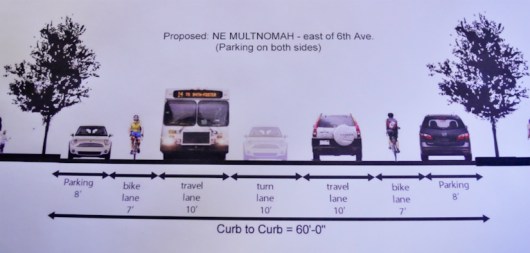
The proposed designs for the bikeways alternate between three types of facilities.
On a few of the block faces, bikes will be directed onto a curbside bike lane physically separated from other traffic by a large (eight foot wide) buffer that will alternate between striped pavement markings and large concrete planters. The drawings aren’t online yet, but I snapped a few photos to give you an idea of what it would look like.
Here’s the drawing for the section just east of SE Grand Ave:
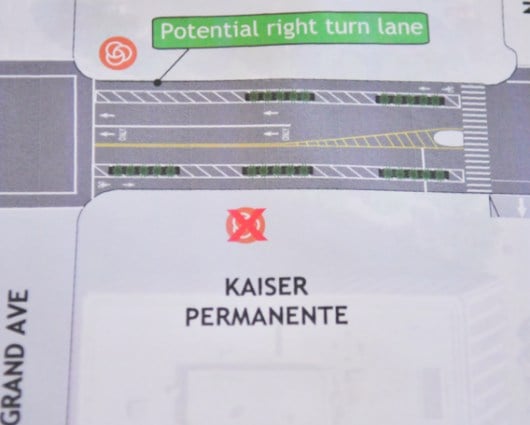
And PBOT was showing this image from Vancouver, BC as an example of the planted buffer:

On many other block faces, where curbside, on-street parking has been added, bikes will travel in a seven-foot bike lane with a one-foot, painted buffer in the door zone. You can see how the curbside bike lane with planted buffer transitions into the more traditional bike lane in the image below (which is the section just east of NE 9th Ave):
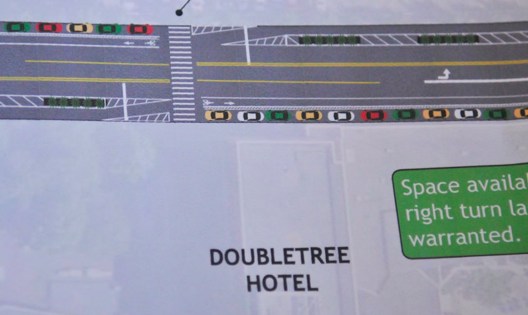
And here’s how it appoaches MLK JR Blvd…

Here’s another section (not sure where, sorry):
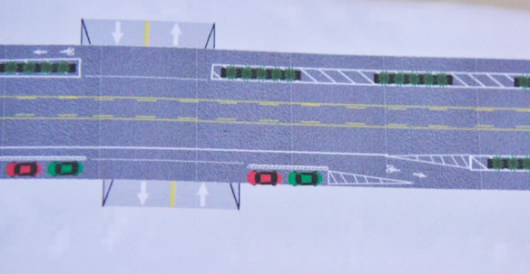
And here’s what they’ve proposed between MLK and Grand:

In just one of the block faces, the bike facility will be similar to the cycle track on SW Broadway, where the car parking is “floating” in the road and it acts as a buffer between bikes and cars. Why is only one section a parking-protected bike lane (which provides more separation and is considered a higher-quality bikeway) while all the other new car parking is directly at the curb? PBOT traffic analyst Wendy Cawley explained that business owners requested the curbside parking. Here’s how it looks outside the 700 Lloyd building east of NE 7th (and it’s worth noting that there’s a massive, 780 unit, $250 million housing and retail project coming to the parking lot just east of that building):
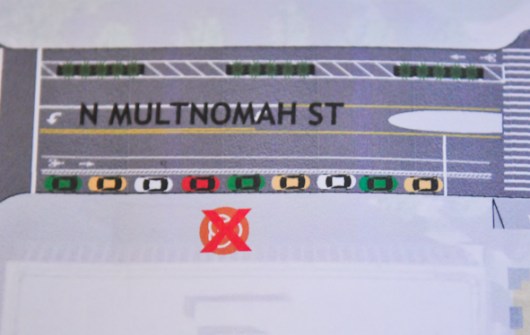
Much like we observed with the opposition to parking removal by the Portland Development Commission and other stakeholders on the Holladay project, parking rules in the Lloyd District. PBOT Director Tom Miller helped explain this for us back in December when he said, “on-street parking is crucial to the success of major, at-grade retail… Retailers need those [parking] stalls. Whether people like it or not, we’re not going to put retail out of business. It’s just not what we do.”
Not to mention that real estate professionals and property owners fight for the spots because it makes their buildings much more valuable when it comes time to sell.
Interestingly, despite proposing to add around 70 new on-street car parking spaces (there are none currently), there are no plans to add new bike parking. Instead of being included in the initial plans, bike corrals are being considered as part of “future streetscape improvements” that “will be encouraged” in the parking zone. Business owners would have to request them before they are installed.
The lanes for cars are direct and straight the entire length of the street; but the bike-only lanes weave between three different types of facilities — moving from curbside, protected zones, then out into a more traditional bike lanes (with no protection from moving cars) and then mixing with buses at intersections. There are even a few intersections where PBOT says they might add a right turn lane.
When I shared my concerns with PBOT traffic engineer Rob Burchfield, he said they’ve set aside space in this initial proposal for future uses such as the corrals, parklets, and maybe even a bike share station. It was also made clear last night that the buffered bike lanes could be converted to more robust, physically separated facilities as part of a longer term “Phase two” of the project.
PBOT says the project will cost about $175,000, with about $90,000 of that to be paid by the Lloyd TMA. It will be considered a one-year pilot project and it could be completed by late summer/early fall of this year. They are accepting comments online from the public and I’ll update this post when I get the link.
Overall, this project as proposed left me very disappointed. Once again, people that choose to bike seem to have taken a back seat to powerful business interests and the need to accomodate automobiles. What do you think?

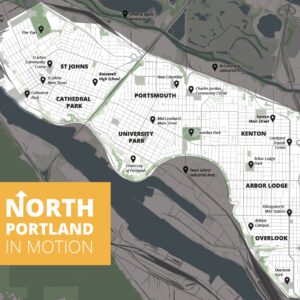
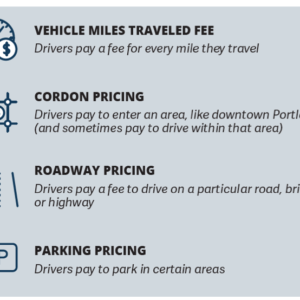


The most amazing thing about this conversion is the cost. With very little money a street can be transformed.
So essentially we get more hodge-podge bike facilities, where neither the people on bikes nor the people driving know what to expect or what’s coming up next, because the facility keeps changing – the deciding factor again between making a consistent, logical bike facility and one that is inconsistent and confusing, is on-street car parking, in a district which already has almost as much surface car parking as it has buildings. Not only can we not remove any on-street parking to make better bike facilities, but now we’re going to add it, and thus complicate what otherwise could be a really simple, straightforward bike facility?
This is just absolutely ridiculous. If Portland wants to do anything more than talk on and on about how much they want to be a world-class biking city, they sure aren’t showing it. In fact, the current bike lanes that are there now are more consistent than this design, and pretty much go straight through all the way from 20th to the Rose Quarter. Sorry guys, this is a big fail.
This isn’t a bike facility. It’s on-street retail parking financed by the city with a bikey smokescreen.
That whole area is a parking lot already.
Not surprising, given who’s behind it, but I agree: disappointing, and roundly NOT “world-class”.
I don’t really understand how the bike lanes could be converted later, except in the sense that any bike lane + curbside parking could be switched around. But it doesn’t look as if there is room for two separated facilities, only two buffered lanes.
I’d rather see two regular buffered lanes all through than this weird combination. I don’t know why PBOT thinks bikes want to constantly change their street position, any more than cars would.
Most of them don’t actually think that, but they are constrained by politics and outdated engineering practices and policies that favor automobile throughput over everything else.
“Once again, people that choose to bike seem to have taken a back seat to business interests and those who drive.” I thought people that choose to bike are business interests 🙂
What has the BTA been doing on this project, were they at the 3 meetings/open house?
That’s one of the problems here Kiel. This task force was an invite-only, private affair that included only city/agency staffers and selected lloyd district business reps. The BTA was not on the task force, nor did the project get vetted by PBOT’s own Bicycle Advisory Committee. There is still time to comment, however, the project has no website that I know of yet. Once online comments are allowed, perhaps then the task force can hear some useful feedback.
oh.. and by “business interests” I am of course referring to lobbyists and business owners who oppose changes to the auto-centric status quo.
“on-street parking is crucial to the success of major, at-grade retail… Retailers need those [parking] stalls. Whether people like it or not, we’re not going to put retail out of business. It’s just not what we do.”
Come on, Tom! Have you checked with your staff about the demand for bike corrals lately? Or perhaps that is what you meant by ‘on-street parking’?
Yeah it’s so funny, I ride a bike.. and i spend money on retail…it’s like they think people who bike don’t spend money. I have MORE Money to spend, because I bike…if I can park is someplace.
Yeah, this is a really weird plan. Why the variety of treatments? Why not just a cycletrack like SW Broadwayat PSU? Is that not curbside parking, in a practical, if not literal sense? Even if you’re 7 feet away from the curb, does that somehow make it not curbside parking? And if there’s not as much parking on that street already, why are they putting it in, and in a way that makes the bike lane system a complete and unpredictable hodgepodge?
–
This whole thing reads to me like it was aimed at attracting or mollifying developers, not at making the streets safer.
I agree that there is some fishy stuff going on here with the real estate interests. I find it very interesting that Ashforth Pacific was advocating against ANY parking removal during the Holladay project while at the same time they were in negotiations to sell a building that would be impacted by that loss. And it’s very obvious to folks in the real estate business that parking availability is a valuable selling point. Then, Ashforth sees an opportunity to add more parking to Multnomah and completely kill the Holladay project in the process. I’ll never forget a quote Ashforth VP Lange said during one of the final Holladay meetings… Something to the effect of, “The bikes already got a win on NE 12th [a related project where bikes got better access to the 12th street overcrossing after some opposition by freight and property owners], so they don’t have to get one here as well.” Classy.
And again we see that idea of bikes as a political idea that needs to be beaten – not PEOPLE who are your neighbors, who buy the things you sell, who stay at your hotels, who eat at your restaurants, who shop at your malls, who watch films at your theaters. I’ve done all of those things in the Lloyd District, and each one of them by bicycle. I’m sick of seeing thousands of people be treated like a concept or idea that needs to be quashed.
Exactly – look at the whole process and who was involved in it. That’s exactly it.
This makes no sense. 1 block of protected lane? Portland is losing. Bigtime.
I see this as an opportunity. Make these changes to Multnomah, and trade the new spaces for the one that can now be removed from Holladay to make the cycle track. The developers will still get a few added parking spots, and cyclists will now have two improved routes.
It’s visionary thinking like this that’s made the Lloyd District such a retail powerhouse over the past 30 years.
Here’s a map with parking lots that face this stretch of Multnomah marked: http://evvywevvy.net/img/multnomah.png
Boy that says it all, doesn’t it?
Hey Everyone, sorry to rain on your activist parade, but making the 5-to-3 lane conversion in the Lloyd district now, right before a ton of development drives more traffic onto Multinomah is a BIG DEAL! Sure, the implementation might not be 100% perfect but don’t lose the forest through the trees. This will be a much-improved facility that will connect the east-side better than anything else could possibly change things. So what if not 100% of the new real-estate is given to bikes? This is a big deal.
BUILD IT.
I hear you Allan… But I don’t think it serves anyone — especially those of who care a great deal about the future of bicycling in Portland — to celebrate what a “big deal” this is. Skinnying down a huge street w/ unused capacity to a more sensible size should be standard operating procedure… As should making direct, protected, convenient and safe access for bicycles and doing more to restrict auto use — not make it more convenient.
The way this project has been led by private business owners and the compromised bikeway and increased auto parking that is currently in the plan, should be called out for what it is… It’s yet another sign that PBOT and City Hall lack the confidence to create truly world-class bikeways and to significantly alter the transportation status quo.
I don’t see how this will be less than ‘world class’ because cars have to park across the lane? because things are non-standard? If there are safety issues with the implementation, they will be addressed. The only thing I think there is a legitimate beef with is the right-turn lane issue.
I think it is good to acknowledge that this is a big deal. Yes, it should be a standard operating procedure to reduce capacity on overbuilt roadways, and if you look at Mayor Adams’ administration, they have done this several times. There are countless locations in the suburbs with similar use characteristics to the 3 lane Multinomah where roads are being widened, speed limits increased, etc. This is a great step forward for the Lloyd district and for urbanizing our central city.
As far as back-room dealing is concerned, it doesn’t bother me when the outcomes are so much better than the status quo. In this case, the end seems to justify the means for me
I hear you Allan. You make some good points. Another one of my concerns is that, after Williams and this project and others, citizens have no clear and consistent expectations about how public process will be managed. That’s not good. If this continues, PBOT will erode the amazing tradition of citizen activism and volunteerism that makes this city great. PBOT needs to have a more consistent process for projects and they need to stick to it, no matter what powerful or political interests look to throw a wrench into it.
And PBOT needs to get out ahead of the curve a little bit; not parrot Cold War truisms equating on-street car parking with economic health. The process does not instill confidence, and the vision is not inspiring.
If only politics worked that way. The rich and powerful will get theirs, no matter what. The only thing I think the city should have done differently is at the beginning is say:
“We want to create an improved east-west bicycle route through the district”
-instead of-
“We want to create a cycle-track on Holliday”.
They overly constrained the project when some key stakeholders were much more willing to give on Multinomah than Holliday. This has been done on other projects as well but I would like it better if they allowed more out of the box thinking instead of just “here’s the project, give us your tweaks”
I have become cynical in the 7 yrs of doing this site, but I don’t agree with that at all. They get theirs if they are given it by our leaders and/or if they do not feel a consequence from the greater public.
I think we need to cater to “key stakeholders” a little less sometimes. I happen to think folks that work at PBOT know much more about how to create a good transportation system than stakeholders do. But yes, this is a tough balance at times. How much should PBOT lead vs. let stakeholders lead? I think right now we are seeing PBOT not leading nearly as much as they should and each time it happens it just erodes their ability to lead that much more.
I was about to write just about the same thing.
We’ll have a new mayor soon enough, then the “ability to lead” resets with this theory, I believe.
I think its really a perception of their ability to lead that has changed, not the actual ‘ability to lead’
The perception of their ability to lead effects their actual ability to lead.
When it happens on every single significant project (Hawthorne Blvd,. Williams, etc. etc.), the system is broken.
Perhaps they were never truly able to lead in the first place, you just thought they could
People here are feeling cheated, because the initial proposal was for a cycle track on Holladay. After much fighting, Multnomah was proposed as an alternative that would be just as good. This proposal is not. It is actually less safe, because it moves many riders into the door zone.
I feel a bit cheated because this project actually initially came to the table as making Holladay completely carfree. So look how far from that we have been compromised.
I wrote more about this one year ago in a post titled, Holladay St. project: From carfree to… compromised?.
Both proposals should encourage more comfortable cycling through the district. One can find flaws with either proposal. I liked both for very different reasons. I think this one may be more timely — as the district grows up the travel demand on Multinomah might have increased to the point where this would not be possible. Doing it now feels like the sort of decision that won’t be reversed
Because the cycling facility is still an afterthought. Perhaps even more of an afterthought than the current bike lanes (they at least have a clear right of way all the way through the district).
I certainly have no great confidence that if there are issues with the implementation they will be suitably addressed any time in the near future. Look at all the bits and pieces of marginally functional bicycle facilities we have all over the city. Not exactly awe-inspiring.
I hope I don’t agree with you when I ride it, but for now I’m willing to wait and see
If Charlie Hales gets elected mayor, none of this will change in the next administration either.
And you think it will with Jefferson Smith of East Portland representing East Portland and only concerned about East Portland?
I’d rather have sidewalks and bike lanes in east Portland than added parking in the Lloyd district… do you want to improve the safety for all pedestrians and cyclists in this city, or just the middle/upper class ones in the central city?
Yes, thats why I think pedestrian and bike infrastructure should be built in the central city where they will benefit ALL of Portland and actually be used. Do I think more infrastracture is needed in East Portland, why yes I do. But also everyone goes to Central City Portland, and believe it or not, there are very poor people in Central City despite the myth that East Portland has a monopoly on the poor and disadvanged and therefore is “more equal.”
No offense, but you imply that everyone that lives and works (and pays property taxes) in East Portland travels to or visits Central City Portland. That assumption comes from a really biased worldview. A lot of East Portland bicycling folks don’t venture west of the Gateway district, and in fact are envious of even having the basics of paved through streets, let alone contemplating new bike facilities on really nice already paved streets with perfectly good bike lanes. The current configuration on Lloyd looks mighty good from this angle, I say spend any new money elsewhere where a couple of bucks would have a lot more bang.
But for the sake of argument on the Lloyd District issue, I have to say that if the Sullivan’s Gulch Trail was built out as a “world class” facility from
Gateway to Downtown, the whole idea of Multnomah or Holladay being the optimal east-west bike throughway would be moot because it would be som much nicer and safer to ride the SGT (if it ever happens).
I’ve seen too many mothers pushing their children in strollers in the gravel on NE Sandy with cars flying by 3ft away at 50mph to have any sympathy for the disadvantaged in the inner-city.
There is a whole world east of I205, filled with people who never come to the central city. Maybe we shouldn’t have annexed it in the 1980s/90s, but we did, and now we have to own up to that.
It’s my impression that there’s also a huge constituency of folks, say 1st generation immigrants east of I205 that don’t want bicycles, transit, or higher taxes (required to pay for sidewalks and paving) that will “prevent them from escaping” east of 205 as soon as they get a generation into whatever legitimate business venture they are into. Being able to move up requires somewhere for them to look down upon and say “that’s where I started”.
On the other hand you have a huge constituency of folks east of 205 that don’t want bicycles, transit, or higher taxes (required to pay for sidewalks, paving and police presence) because they associate all those things with what they perceive as blight on their once 50’s dream suburb brought about by gentrification in the inner city.
They really need to fix the east travelling portion of NE MUltnomah just before the intersection with MLK. Busses and other large vehicles constantly cut the corner making the bike lane unusable. Also a green bike box or something could do a lot to prevent auto traffic from right hooking cyclists as the light turns green.
I was sorry to be unavailable for the open house. Did PBOT make the materials available on-line?
I was told at the meeting they would have them up today or very soon. they are also supposed to have an online form for public comment. I have not seen them yet. I’ve got an email into PBOT and will update when I learn more.
Not acceptable.
Jonathan: If you get a chance to interview the candidates for mayor as well as Fritz & Nolan, I’d like to read their thoughts on this project.
This is a joke, just like the Lloyd TMA. This has nothing to do with bike and all to do with parking. This group consisted of mostly rich and powerful. Home many Lloyd residents were in the group? How many people with money that live in the Burbs? Nice. Great job.
I know this is BikePortland, but why is on-street parking seen as such a problem? Personally, I would love to see businesses on the street thrive and I think that on-street parking has a non-zero benefit to helping shops make it. Perhaps too many of us have been doored? The city wasn’t going to create a 16 foot wide bike lane, and I don’t think I would want them to.
“why is on-street parking seen as such a problem?”
I am going to venture that this was not a rhetorical question?
Let’s start with Donald Shoup’s The High Cost of Free Parking
http://www.nytimes.com/2010/08/15/business/economy/15view.html?_r=1
a few quotes from the NYT summary of his argument:
* As Professor Shoup wrote, “Minimum parking requirements act like a fertility drug for cars.”
* the parking subsidy outweighs many of the other costs of driving, including the gasoline tax.
* Many parking spaces are extremely valuable, even if that’s not reflected in current market prices. In fact, Professor Shoup estimates that many American parking spaces have a higher economic value than the cars sitting in them. For instance, after including construction and land costs, he measures the value of a Los Angeles parking space at over $31,000 — much more than the worth of many cars, especially when considering their rapid depreciation. If we don’t give away cars, why give away parking spaces?
* Shoup estimated that the value of the free-parking subsidy to cars was at least $127 billion in 2002, and possibly much more.
* PERHAPS most important, if we’re going to wean ourselves away from excess use of fossil fuels, we need to remove current subsidies to energy-unfriendly ways of life.
9watts, for the record, the on-street parking is proposed to be metered.
Thanks, Craig. I guess that’s a start.
Allen, this proposal introduces a hazard that doesn’t exist today on Multnomah: the door zone. Whether parking is to the left or right of the bike lane, wherever there is on-street parking bikes will be in the door zone.
The plans describe the proposed parking as buffered in spots, but the one-foot buffer is nominal at best, when a truly functioning door buffer needs to be three feet at a minimum to keep bikes out of range of opening doors. The proposed increase of bike lane width to 7-feet is an illusion if riders are expected to ride in such a way that they must cede three or four feet of it to the door zone–exactly the conditions on N. WIlliams today.
For myself as a dad riding through the Lloyd District regularly with four kids in on bikes, this proposal makes Multnomah less safe, and less comfortable than the status quo. I said as much during the TMA’s stakeholder meetings this winter.
Sorry: “Allan”, not “Allen”.
The problem is not the addition of the parking, but the fact that maximizing perceived value to businesses led to a door-zone bike lane in most blocks rather than a cycle track. I would much prefer a cycle track to a door-zone bike lane.
BURR:
If Charlie is elected it WILL change: there will be streetcars running in the right-hand lanes on top of the bike lanes.
This wouldnt be bad if HOLLADAY was going to be a cycle track. Fine, go ahead with this but bring back the Holladay plan, this Multnomah scheme provides the cherished parking spaces that apparently was the problem with Holladay as a cycle track.
Plus how about stop prioritizing through auto traffic on that street with the waste of space known as a ‘turning lane’ in the center. The sign of a suburban street are turning lanes because godforbid turning vehicles slow the almighty long distance traffic racing to get through the neighborhood.
I work in the 700 building and find the worst part about Multnomah is the timing of the lights and playing leapfrog with the buses. As far as on street parking, there really isn’t that much ground floor retail on the street now and I can’t imagine where it would be added…the planned apartment buildings?
I think city planners are hoping for infill development like the planned apartment buildings. They may be on the right track here, as there are tons of silly surface parking lots in this district, just begging for infill. A cycle track on Holladay would round out the low-car transportation options in this area nicely. Residents would have shopping, MAX, streetcar, and bike facilities within a few blocks.
There seems to be a real chance that there will be some higher density semi-affordable housing built in the Lloyd district which the inner east side needs much more than cycle tracks, the increase in density would contribute to an actual long lasting transformation of interactions within the shared social space amongst residents, tourists, and workers. If this is the compromise required to expedite the construction of the housing so be it.
And the argument about subsidizing environmentally unfriendly behavior is tricky because reproductive choices are exponentially more damaging than transportation choices, and human reproduction is heavily subsidized.
I can’t imagine that Portland planners aren’t hoping for infill development; I’m not so sure what Ashforth and other developers are thinking. The two street renderings in this article are both relatively low density, including single-story buildings (probably retail). Instead of fretting about parking for those retailers, why not increase density via mixed use (commercial/residential) so the retail customers are living close enough they don’t need to drive and park? Taller, denser development would also include structured parking, some of which could go to short-term customers, even eliminating on-street parking. I hope Portland doesn’t lose this opportunity to make the Lloyd district a dense, urban center like the Pearl, developers and city planners! (The proposed mediocre bike facilities are all too suggestive that they don’t ‘get it’ yet.)
There seems to be a real chance that there will be some higher density semi-affordable housing built in the Lloyd district which the inner east side needs much more than cycle tracks, the increase in density would contribute to an actual long lasting transformation of interactions within the shared social space amongst residents, tourists, and workers. If this is the compromise required to expedite the construction of the housing so be it, single family homes need to go the way of the DoDo.
This is really disappointing, because it could be an excellent improvement with just a few changes.
We all need to advocate for having the parking to the left of the bike lanes for the whole distance.
Basically, the existing 4 to 5 foot bike lanes would remain in place, a 3 foot buffer would be added to the left, and then 7 feet for parking, bike corrals, trees and whatnot would go to the left of that. This leaves the central 3 lanes the same, and generally should fit in with the plans above. And now bikes will be out of the door zone and away from cars, while the business owners get the on-street parking that they want.
I agree on this. One of the benefits of curbside parking, however is the opportunity for parklets which does not exist with a curbside bike lane. Of course we’re talking well into the future here, when people are on the street. I hope that the curbside parking is adequately buffered so that there are no problems with this design. It would be a shame if the new facility sucks because of this failing. I have to imagine with 16 feet to work with the City will get it right.
It also looks like they are moving the bus stops around? Multnomah is a major bus thoroughfare. Is the leapfrogging that already happens here going to get worse?
I’d also be curious about the length of the meters that will be added. The 5 hour spots mostly get used by people who work in the district. Adding more will definitely encourage more auto commuting, and therefore more auto traffic.
Personaly, I love how it was a long “public” process on Holladay, but a quick “stakeholder” process that actually gets done on Multnomah. And look how fast this is getting built out. If they were planning on paying any attention whatsoever to the “public”, there is no way they should be planning to have it done by fall. And, relating to other matters, if Multnomah can be restriped this quickly by PBOT, maybe their crews could help ODOt redo the St John’s Bridge…
Seriously… some projects take years, others just burst into existence. I think the ‘demonstration’ or ‘pilot project’ name is what lets them do it.
I guess I’ll just keep taking Holladay eastbound. and Lloyd Blvd westbound. Was anything said about improving the Lloyd district to Esplanade connection? Right now it’s probably the most dangerous/stressful part of my whole commute.
Regarding East Portland vs. Central City – I know it’s tempting to want to get into a battle about who should get resources, etc – and I totally understand the frustration of folks in East Portland, nor do I disagree that they get much less and really should get more. However, I think as tempting as it may be, we might be better off all fighting together to, as Jonathan said in a comment above, make good bikeway design and implementation simply a standard operating procedure city-wide, rather than arguing about who gets what piece of the money right now.
Think about this project this way – if we get them to do Multnomah really well (it’s either going to be done well or poorly, but it’s going to be done), they’ll have a basis to go on, and some good design ideas, when we push them to do something with, for instance, NE Glisan out past 82nd. If it gets done poorly, the chances of any changes made in the future to East Portland are that they will get done equally poorly, because we won’t have pushed them to try anything new, and we’ll just get the same old thing.
I think it might be better, all-in-all, if we get them to solidify good design now, before they start hodge-podging East Portland like they have the central city.
Anyway, just some thoughts.
Agreed. We need to keep focusing on the big picture, and we need a better redesign on Multnomah. It’s just so disappointing when riding out a street like NE Glisan that you have to wait to cross out of the Portland city limit and into City of Gresham’s jurisdiction for the the bike lanes to start up on this busy arterial street. It’s worst when you’re inbound on Glisan & get to 162nd and you see that “Entering Portland” sign just as the bike lanes disappear, it just smacks you in the face. I know it’s just striping, but like sidewalks, they do add safety.
I think this project is a workable compromise with some areas in need of improvement. I am as wary of a door-zone bike lane as others on here, and would prefer a curbside bike lane treatment throughout. I do think that there are tangible safety benefits to reducing the overbuilt roadway to one lane in each direction, which will calm traffic speeds, and increasing the number of midblock crossing opportunities, a necessity in a district of superblocks. Reducing the travel lanes to 10 ft in each direction shows a commitment to dedicating as much space as possible to bicycles given the ROW constraints. Now whether the center turn lane is really necessary in most places is another story altogether.
Bottom line, this project can be a worthy improvement to cycling in the Lloyd District, IF they continue forward with the Holladay cycle track project. I do not support Multnomah as a “replacement” for Holladay, as the parking they’ll add on Multnomah should mitigate most spaces lost on Holladay.
Today was Bike to Work Day, and the Multnomah Street Plan was on display at an outdoor gathering this morning in the Lloyd District. A PBOT representative was there for Q&A. I asked if PBOT plans to take comments via the internet, and the staffer cited the bureau’s lack of internet expertise/resources to do that, so the best/only way for electronic comments is to submit them to the project manager, Ross Swanson, at ross.swanson@portlandoregon.gov .
Just emailed him some comments – let’s get a ton of people sending stuff in, make some constructive noise and hopefully we can get them to re-consider this and think about making it a really honestly great facility.
exactly there’s the equity preaching hipster living in the inner city hipster belt of portland that wants to impose their view of what east portland should be. there are also many long time residents who live in east portland who want east portland to remain the autocentric 1950s suburban dream it was built to be, why should an urban lifestyle be imposed on their neighborhood, its not even compatible with its built form.